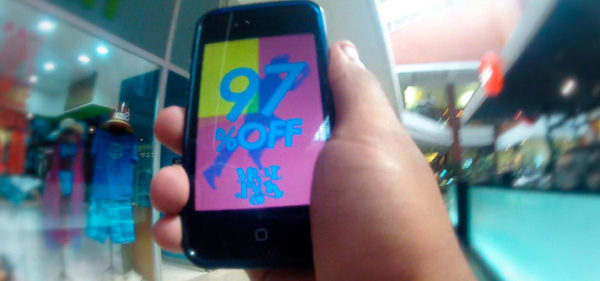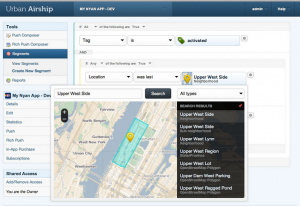How You Can Use Geo-Location To Turn Mobile Traffic Into Offline Gold
Mobile traffic is on a steep upward climb, with people now looking at their mobile devices an average of 150 times per day. Businesses that aren’t selling an ecommerce-friendly products will need to get very creative if they are to transmute this increasing mobile traffic into more revenue. But even businesses that have the advantage of […]
Mobile traffic is on a steep upward climb, with people now looking at their mobile devices an average of 150 times per day.
Businesses that aren’t selling an ecommerce-friendly products will need to get very creative if they are to transmute this increasing mobile traffic into more revenue. But even businesses that have the advantage of products which are easy to order online still need to find clever ways to capitalize on such an active mobile user base.
One of the emerging mobile marketing opportunities that brands can take advantage of is to use geo-location technology to reach users with timely, in-device messages.
The ultimate objective of these messages is to drive customers to the brand’s nearest store location to eat, shop or interact with a professional (such as a financial advisor or car dealer) who can close the sale.
With a well-crafted, geo-aware mobile campaign, a customer’s movement through space becomes an active and seamless virtual search engine that provides timely and relevant data, which triggers a message that raises awareness and serves up valuable incentives.
Let’s break down the geo-location landscape a bit before looking at two brands that are using this strategy to convert mobile traffic into more customers. First, it’s important to understand a few key components of the technique.
Geo-Location
This simply refers to the ability to pinpoint a device’s current location. This isn’t new technology, per se. Websites have been decoding desktop IP addresses for years in order to personalize content, such as displaying a user’s local language or serving up prices in a region’s currency.
What is new is the improved ability to get an accurate read on a mobile device’s specific location using its built-in GPS chip. This technology empowers mobile marketers because the coordinates are both precise and timely. The savviest marketers are now using location as an additional attribute, or data point, within a larger personal profile that might contain demographic information, individual purchase history or inferred intent like time-of-day.
Geo-Fencing
Geo-fencing is defining a geographic region which, when entered, will trigger some type of action — this could be a display ad, an in-app action or specially tailored search results.
A geo-fenced region can be fairly large — for example, using an airport and its 10-mile radius to target potential last-minute hotel guests — or quite precise, like a specific retail location within a city block.
Geo-Conquesting
This is a strategy that uses geo-fencing techniques for the express purpose of marketing to a customer who is near a competitor’s space. This isn’t such a new concept, either. Long before in-device geo-aware tactics were possible, companies were attempting to lure customers away from their competitors using similar methods.
Just look at a typical corner gas station — odds are there’s a competitor across the street or on the next corner running some type of special promotion intended to sway you toward their location. Similarly, search marketers often bid on competitor terms within paid search advertising. Geo-conquesting is simply a mobile-specific use of this strategy.
How Popular Is Geo-Aware Marketing?
Not all brands use geo-aware data in their mobile marketing campaigns, but those that do are heavily leveraging geo-conquesting as strategy.
Mobile ad network xAd reported that nearly one third of campaigns that used geo-aware data used geo-conquesting as a component of their strategy.
Who’s Using It?
The top five industries utilizing geo-aware campaigns, in order of popularity, are restaurants, retail, financial services/insurance, travel, and gas/convenience.
This should come as no surprise, as many of these verticals aren’t able to take advantage of a simple click-to-convert mobile transaction.
Is It Working?
Well, yes… but with some caveats which we’ll explore in a moment. First, let’s look at examples for two of the top categories: restaurant and retail.
Outback Steakhouse Fuels Appetites
Ad network xAd recently published another interesting case study in which Outback Steakhouse used geo-conquesting to drive diners away from competitors and into their location.
A geo-fence was set up in a 10-mile radius of its casual dining competitors and a 5-mile radius around its own locations. When a potential customer entered the region, a display ad would pop up in an app likely to have location services active (such as Weather Bug). Diners would be reminded of specials and other menu promotions, and the click-through would direct users to a landing page with the nearest Outback Steakhouse location.
The campaign’s success was measured not only by clicks on the display ad, but also by post-click activity on the landing page as well as the level of in-store traffic within the testing region.
Overall, an 11% increase in conversions was reported. This level of attribution was key to understanding the positive impact of the campaign because the CTR (Click to Responder) data was flat on which landing page and in-store traffic was higher for the regions using the geo-aware campaign.
Meat Pack Hijack Hijinks
Edgy Guatemalan sneaker retailer Meat Pack is one of my favorite examples of geo-aware mobile marketing. The campaign was simple, fun and completely on-brand in its creative execution.

Meat Pack used their native app to detect when a former customer entered a competitor’s retail space. When the customer entered a competitor’s location, a fun, high-energy promo offering (video autoplay) the customer a 99% discount would appear. The discount percentage decreased one percent each second until the user entered a Meat Pack store. That discount could then be applied in-store.
The campaign saw over 600 people “hijacked” from rival stores, and the fastest person to get there managed to receive an 89% discount.
Both Outback and Meat Pack relied on in-app messaging, but that’s just one of many techniques that can be used. Almost any push or pull direct mobile marketing format can be triggered by geo-aware data. Depending on the intent, tailoring search results can be just as effective as display ad.
What Challenges Do Marketers Face?
Below are some of the hurdles that marketers might face when using geo-location technology to reach users with timely, in-device messages.
Getting An Accurate Real-Time Location
The best way to locate a potential customer’s current location is to access the GPS chip on their smartphone or tablet. Typically this will be able to pinpoint a user to within 20 feet of their actual location, with updates every 30-60 seconds.
The problem is that users need to grant permission for you to access this feature. Many savvy users turn the “find location” option off if they don’t think an app requires that information to perform its chief duty, which prevents marketers from using this data point to trigger a campaign. This is why brands often choose to partner with apps like Weather Bug that are likely to have the location service enabled and are accessed frequently by the user.
Attaining A Large Enough Audience To Target
Most brands that are diving deep into geo-based marketing are doing so in small, concentrated test markets. Even within these test cells, the active audience can be quite small since the campaigns rely on the GPS capabilities that must activated within an app in order to trigger the messaging.
Matching Strategy & Creative With Inferred Intent
Customers using mobile devices are in a different mindset than when they’re at home on a laptop, and determining their intent is nuanced. As John Cosley mentions in his recent article, showing an ad might not be the right creative for a given situation. It may be more effective to lead to educational or informational content like search results.
And Finally, Attribution
Many brands struggle to follow a customer across multiple properties and experiences. Unless there is an extremely diligent testing methodology in place, like in the case of Outback Steakhouse, it’s difficult to get true insight into how effective these campaigns prove to be. Click-to-call tracking, landing-page optimization and in-store Bluetooth-enabled beacons are starting to fill in the gap in conversion paths; but, gaps continue to plague marketers.
Even with these hurdles present, geo-aware mobile campaigns offer a rich opportunity for brands that have a tough time integrating the mobile revolution into their marketing strategy and brick-and-mortar business models.
Contributing authors are invited to create content for MarTech and are chosen for their expertise and contribution to the search community. Our contributors work under the oversight of the editorial staff and contributions are checked for quality and relevance to our readers. MarTech is owned by Semrush. Contributor was not asked to make any direct or indirect mentions of Semrush. The opinions they express are their own.
Related stories
